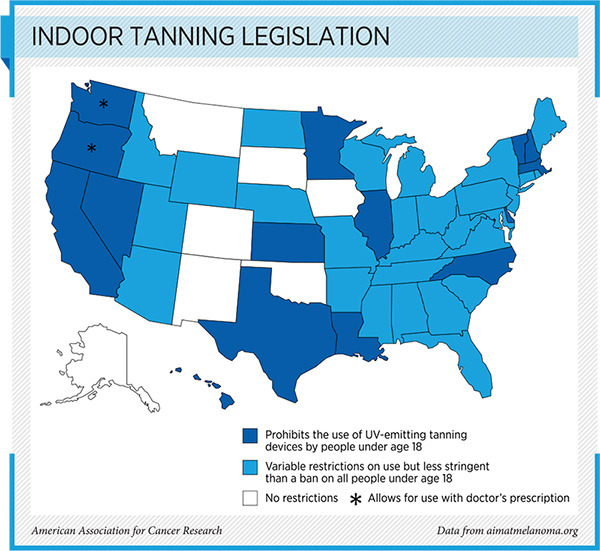Why Shouldn’t I Tan Indoors?
Before you try to banish the winter blues by adding some color to your skin with a trip to the tanning salon, remember that exposure to ultraviolet (UV) light from indoor tanning beds, sunlamps, and tanning booths increases your risk of developing skin cancer.

Squamous cell carcinoma cells. Squamous cell carcinoma is the second most common form of skin cancer diagnosed in the United States. Image courtesy of the National Cancer Institute.
UV-emitting tanning devices were first classified as capable of causing cancer by the International Agency for Research on Cancer, part of the World Health Organization, in 2009. Since then, it has been calculated that these devices cause about 8 percent of the cases of melanoma—the most deadly form of skin cancer—diagnosed each year in the United States. This means that in 2016, more than 6,000 cases of melanoma were attributable to using UV-emitting tanning beds, sunlamps, and tanning booths.
New research, published recently in the Journal of the American Academy of Dermatology, estimates that more than 61,000 cases of melanoma over the lifetime of the 61.2 million youth age 14 years or younger in the United States could be prevented if people younger than age 18 were banned from using UV tanning devices.
The researchers also estimated that such a ban would save $342.9 million in treatment costs.
The most recent data show that in 2015, 7 percent of all high school students reported using a UV-emitting tanning device at least once during the 12 months before being surveyed. Although this was down from 13 percent in 2013, it is clear that more needs to be done to reduce the number even further.
Research has shown that female high-school students living in states with laws restricting the use of UV-emitting tanning devices are less likely to use such devices than those in states without restrictions. However, as of Dec. 1, 2016, only 13 states and the District of Columbia had enacted laws banning the use of UV-emitting tanning devices by people under age 18. Two other states had laws banning a person under age 18 from using UV-emitting tanning devices unless he or she has a prescription from a physician. A number of other states have laws that impose less stringent restrictions on the use of UV-emitting tanning devices, but eight states have no laws restricting the use of such devices.
As discussed in a previous post on this blog, the American Association for Cancer Research (AACR) joined with more than 20 health and cancer-related organizations in July 2015 to call for broad implementation of state and federal legislation to prohibit the use of indoor tanning by minors under the age of 18.

In late 2015, the U.S. Food and Drug Administration (FDA) issued a proposed rule that would restrict the use of UV-emitting tanning devices to those age 18 and older. The agency accepted public comments on the proposal for 90 days, during which time the AACR, in conjunction with the Association of American Cancer Institutes (AACI), submitted comments in strong support of the proposed rule. A final rule is still pending, but the new research only adds to the growing evidence that implementation of a ban on the use of UV-emitting tanning devices by people younger than age 18 could, in combination with other legislation and public education campaigns, significantly reduce the personal and financial burden of melanoma in the United States.



